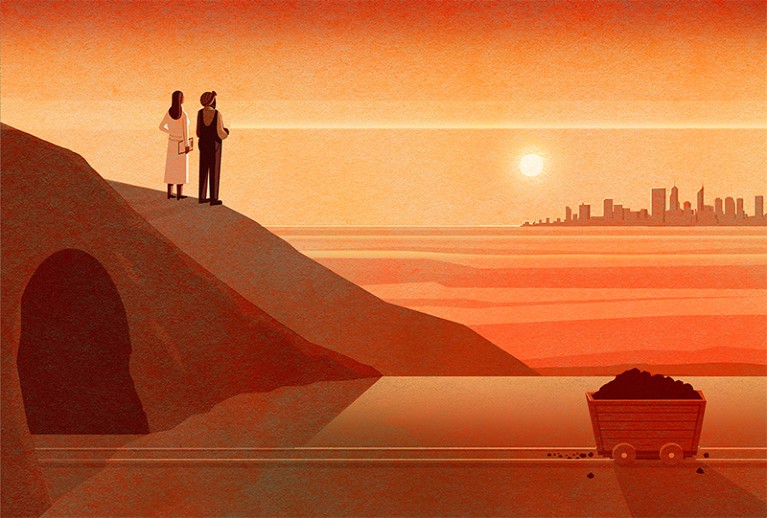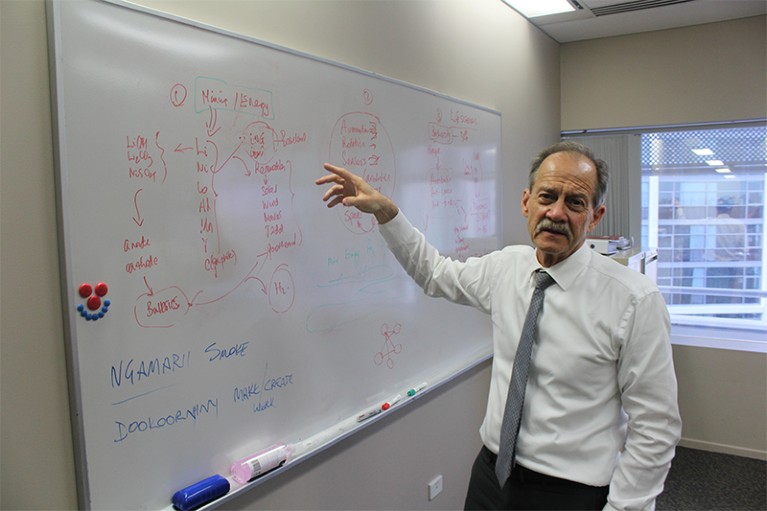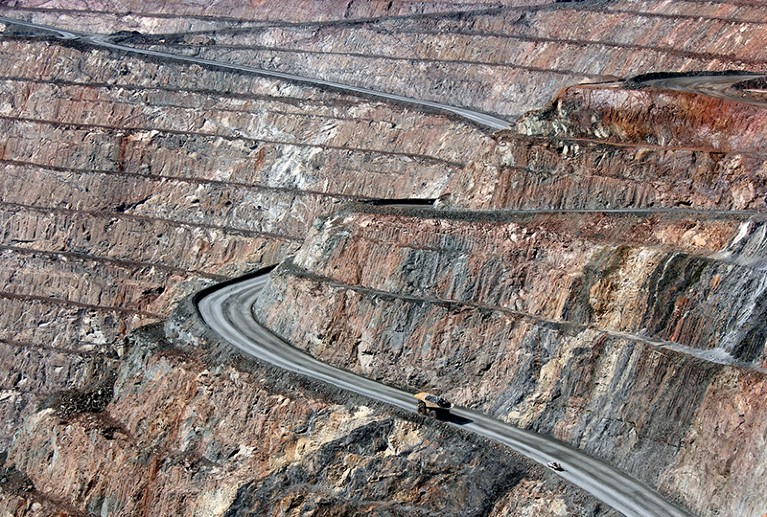
Illustration by Marco Melgrati
The largest of Australia’s six states, Western Australia covers about one-third of the country’s landmass, and is home to 11% of its population. Almost three-quarters of residents live in the coastal city of Perth, the state capital. The next-nearest large city is Adelaide, a three-hour flight away in the neighbouring state of South Australia.
Sometimes, says George Yeoh, this isolation makes his life difficult. “If we go over east, it’s probably a couple of days,” says Yeoh, a liver researcher who runs the Centre for Cell Therapy and Regenerative Medicine at Perth’s Harry Perkins Institute of Medical Research. “When I invite people from Melbourne or Sydney to give a talk, they say, ‘Sorry, George, I made other commitments; I can’t fly in in the morning and fly back the same day’.”
All of this gives Western Australia in general, and its research scene especially, a sense of independence. “We tend to think a little different from the folks on the east seaboard,” says Yeoh.
Perth sprawls inland from the coast for approximately 50 kilometres, from a steel-and-glass city centre around the Swan River to well-spaced rows of garden-flanked dwellings, most of them bungalows, which give way first to crop fields and then to a red–orange rusty brush scratched with dirt tracks. Much of the state’s 2.6 million square kilometres is sparsely populated and has rarely been visited — except by Indigenous Australians who arrived on the continent at least 65,000 years ago.
Across this vastness, Western Australia’s outback is studded with plentiful reserves of precious metals and minerals. When gold was discovered in the 1890s in Kalgoorlie, now a seven-hour drive from Perth, the resulting economic boom transformed Perth from a small provincial town into Australia’s fourth most-populous city.
Much of the state’s economy — and science — is dominated by the resources sector, which covers the exploration, extraction and processing of minerals and hydrocarbons. Curtin University is one of five universities in Western Australia, four of which are in Perth. It is a world leader in mining technology and research.
Isolation
Many west-coast scientists feel that their work struggles to hold the attention of funding agencies and the federal government in Canberra. Researchers suspect that the government prefers the nearer and larger cities and the biotech hubs of the east coast.
“I tell my students that is something we need to overcome,” Yeoh says.
“We have to be very collaborative here,” agrees Sue Fletcher, a biomedical researcher at Murdoch University, also in Perth. “We’re a smaller city. We don’t have the same number of institutions with big expensive equipment, so the universities work together really well to access each others’ facilities.”
Data support this perspective. A 2016 report by Nature Index, which tracks scientific-article author affiliations, found that Curtin University and the University of Western Australia (UWA) formed Australia’s strongest collaboration between two research institutes, coming 73rd globally. No other Australian university made it into the list of the top 100 partnerships. The data also showed that Curtin was the most collaborative Australian university overall.
“Collaboration comes naturally here,” says Robyn Owens, deputy vice-chancellor for research at UWA. “It’s only by doing that that we can ensure we have the appropriate research infrastructure in Western Australia.”

Peter Klinken, Western Australia’s chief scientist, has radical plans for science’s role in shaping the state.Credit: Jack Leeming/Nature
Peter Klinken, the state’s chief scientist, says scientists in Western Australia must be proactive if they are to collaborate farther afield. “From my perspective, don’t whinge about it. Get out and do something about it. You have to be prepared to do a two-day trip. A lot of decisions are made in meeting rooms or in corridors or over a cup of coffee. We don’t have that luxury here.”
Klinken is an energetic man, with radical plans for how science could shape Western Australia. Twenty minutes into an interview with Nature at his office in Perth, he spins out of his chair to gesticulate at a whiteboard bearing multicoloured scrawls indicating specific areas of interest: “Li”, “Automation”, “Biodiversity”.
Klinken has a vision for encouraging even deeper collaborations between Western Australia’s universities, by merging them into a single institute, in the style of the University of California system or the federated universities of London. “I have one suggestion: that all of the universities are called the University of Western Australia and there are four campuses,” he says. “It’s a way of getting greater coordination.” Klinken acknowledges that he “was met with stony silence” when he first suggested this to university executives. But, he says, “I have raised it seriously at the highest levels of the state. And the universities are established under state acts of parliament.”
He argues that a single, larger, more prestigious university would also help to draw more international students to the state — international education is Australia’s third-largest export, in terms of dollars, and Western Australia provides only 8% of the country’s total. “It could be a way of addressing that,” Klinken says, adding that a similar merger is being discussed between the University of Adelaide and the University of South Australia.
Extractive economy
The two tallest office buildings in Perth stand next to each other on the city’s waterfront, dominating both the skyline and the Western Australian economy. They are mainly tenanted by mining giants BHP and the Rio Tinto group. Together, the companies reported profits of US$15 billion last year.
Mining directly accounted for 29% of the state’s gross product last year. Some 85% of the state’s merchandise exports in 2017 were in minerals and petroleum. Around half of the state’s mining exports go to China.
This reliance on the resources sector means “Perth suffers from a cyclical boom-and-bust existence”, says Justin Brown, a geologist who founded and runs the mining company Element 25. “The heartbeat of Perth rises and falls on the health of the resource industry.”

A truck climbs the ridges of the Firmiston Open Pit gold mine, known as the ‘Super Pit’, in Kalgoorlie.Credit: Jack Leeming/Nature
Perth’s heartbeat is especially arrhythmic because very little is done to the ore in Western Australian itself. “We dig up big rocks, turn them into little rocks, load them on a ship and sell them,” says Klinken.
Element 25 has been trying something new to break that cycle, by partnering with research organizations to process manganese from ore deposits that the company discovered in 2010, about 1,000 kilometres north of Perth. The discovery is the largest onshore manganese resource in Australia: enough, if it was all converted into metal, to meet the world’s total demand for the resource for an entire year.
Under normal circumstances, Brown’s manganese deposit would have been dug up and exported to China to be converted into steel for the country’s construction industry, in a toxic, energy-hungry process. Ninety per cent of the manganese that passes through human hands goes into industrial steel alloys.
Just when Element 25 would normally have been arranging a sale of its ore to China, however, the effects of the global recession brought the world’s construction sector to a standstill. In 2013, iron-ore sales alone brought around Aus$75 billion (US$46 billion) to Western Australia. Two years later, that figure had dropped to less than Aus$50 billion. Demand for manganese slumped.
To save costs and pursue a manganese market not involved in construction, Element 25 partnered with the Mineral Resources unit at Australia’s national Commonwealth Scientific and Industrial Research Organisation to develop a process that can leach 95% of manganese from ore at room temperature and pressure within 30 minutes — without any of the dirty processes used in China’s steel production.
The partnership was made possible by a grant from the federal government, designed to link industry and research, of Aus$100,000. This was matched and then added to by the company. “We have a much cleaner, cheaper leaching step,” Brown says. “It’s really fun science.”
Natural resources
Australia’s reliance on natural resources is a hot political issue. Last month, the country’s new prime minister, Scott Morrison, abandoned Australia’s emissions-reduction policy, and thus effectively its commitment to the 2015 Paris climate agreement, making Australia the second developed country to do so after the United States. The move came during a period of drought and wildfires along the eastern seaboard, and in spite of a public poll suggesting that 70% of Australians want the government to end the country’s dependence on coal.
The effects of those sentiments are being felt by Curtin’s Mineral and Mining Engineering programme, the second best in the world behind the Colorado School of Mines in Golden, according to the 2018 QS World University Rankings. Undergraduate student Anis McGowan says that the resources industry is facing a recruitment crisis owing to environmental concerns about mining in Australia and because of the tough working conditions in many mines. She finds this frustrating: environmental impact aside, mining is still an essential means of satisfying the world’s demand for resources. “If it’s not grown, it’s mined,” she says, shrugging.
Sam Spearing, who runs Curtin’s school of mines at the Kalgoorlie campus, where McGowan is studying, says, “We’re missing around two-thirds [of our usual undergraduate cohort] this year. It’s bad.”

The quokka, with its permanently chipper expression, is a major attraction among visitors to Western Australia. It’s also severely endangered on the mainland.Credit: John Crux Photography/Getty
Ecological costs
One source of opposition to Western Australia’s mining sector comes from another unique element of the state’s geography: its flora and fauna.
Roberta Bencini, a fauna ecologist at UWA, says that the area’s isolation by vast deserts, and the even vaster ocean surrounding Australia, has given rise to a huge diversity of species found almost exclusively in Western Australia. These include exotically named and severely threatened creatures, such as the dibbler (Parantechinus apicalis), quokka (Setonix brachyurus), chuditch (Dasyurus geoffroii) and noisy scrub-bird (Atrichornis clamosus) (respectively, a small nocturnal carnivore, a marsupial with a seemingly permanent smile, a cat-sized carnivore and an aptly named bird).
“We have unique plants, unique animals,” says Bencini, “but we have an array of habitat destruction, creating a big issue.”
The short gestation periods of marsupials — the dominant group of mammals on the continent — make them especially vulnerable to anthropogenic changes, because populations can take much longer to recover from harm than do mammal populations elsewhere in the world.
Take the tree-dwelling western ringtail possum (Pseudocheirus occidentalis), for example. “It’s an arboreal mammal — it’s restricted by an area where there’s a continuous canopy. They don’t like coming to the ground,” Bencini explains.
Because of this, a badly routed highway can cut local habitats in half. “There’s been a 99% reduction in their inland population,” says Bencini, who five years ago oversaw a successful project to build a rope bridge over one road, melding a possum habitat back together.
Another thing that’s been cut too aggressively is funding for ecology research, adds Bencini. “We’ve been working on a shoestring budget,” she says. “Instead of collaborating, we’re competing for grants and funding; it’s becoming cut-throat. It’s very dire at the moment.”
Stargazing
Western Australia’s geography is essential to another scientific field: astronomy. The central area of the vast state is largely uninhabited, with little radio coverage — making it perfect for detecting faint radio signals from elsewhere in the Universe.
“It’s radio quiet here,” says Melanie Johnston-Hollitt, an astronomer who runs the Murchison Widefield Array at Curtin. “It’s flat, it’s dry most of the time and it’s got this fantastic view of the sky — there’s nothing there.” However, the Western Australian deserts’ frequent lightning storms can occasionally affect individual units in the array.
The Murchison project is an international collaboration to study and map the wider Universe in low-frequency radio waves. It is also being used as a test bed for various technologies that might be adopted by the Square Kilometre Array — a much larger proposed project that, if funded, will be built in South Africa and Western Australia.
Move away from coal
But there are signs that Western Australia’s economy is diversifying. Lithium — a resource of which the state has deep reserves — is in growing demand as the world hopes to manufacture more lithium-ion batteries. Instead of selling the ore, Western Australian policymakers are hoping to position the state as a battery manufacturer.
To back up this change of heart, Klinken is fast to point out that the state’s Labor government has made science and technology a major part of its latest policy document.
For Klinken, renewable energy offers the state an opportunity. “We’ve got great sunlight here — more than anywhere else in the world. It’s [got] the second windiest capital in the world, after Wellington,” he says. “We have an opportunity to make a transition away from coal.
“All of the energy companies are saying, ‘What’s next?’ I haven’t seen a change in mindset like I’ve seen in the last couple of years from these big energy players. It’s moving at a pace I absolutely did not expect,” Klinken says. “The world is changing. You can feel it.”
“If I was doing a PhD, I would be more optimistic of prospects in the future here,” says Yeoh.
For Klinken, this isn’t enough. “I think this is a unique moment. If we grasp it, this state will really take off. If we don’t, I shake my head at what my kids and grandkids will say to me. There’s something about this time here that says we really need to grasp the nettle.”

 Australia makes its mark in biotechnology
Australia makes its mark in biotechnology
 Australia cuts conservation protections in marine parks
Australia cuts conservation protections in marine parks
 Career Guide: Australia
Career Guide: Australia








